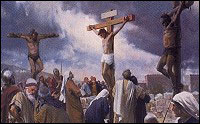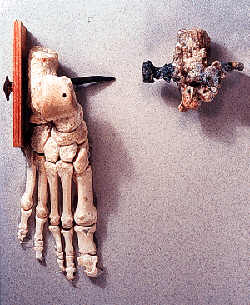|
Confirmation Regarding the Crucifixion

All four Gospels give details of the crucifixion of
Christ. Their accurate portrayal of this Roman practice has
been confirmed by archaeology. In 1968, building contractors
found four cave-tombs at Giv'at ha-Mivtar (Ras el-Masaref),
which is just north of Jerusalem near Mount Scopus and
immediately west of the road to Nablus was uncovered.
Within the caves were found fifteen limestone ossuaries
which contained the bones of thirty-five individuals. Nine
of the thirty-five individuals had met violent death. One of
these, a man between twenty-four and twenty-eight years of
age was crucified.
The name of the man was incised on his ossuary in letters
2 cm high: Jehohanan. He was crucified probably between A.D.
7, the time of the census revolt, and 66, the beginning of
the war against Rome.

Heelbones found
The practice dates back to at least 500
B.C., first coming into use in the Middle East via Persia
and Egypt. The
Romans, who may have borrowed it from Carthage, reserved it
for slaves and despised malefactors. Crucifixion was
particularly effective in sending a message to seditious
populations concerning the likely fate of those who tamper
with authority. It was common practice among the
Romans to scourge the prisoner and to require him to carry
his cross to the place of crucifixion. The prisoner was
either nailed or tied to the cross, and, to induce more
rapid death, his legs were often broken.
Maxtin Mengel, wrote what is perhaps the definitive
scholarly report of the subject of Crucifixion in antiquity,
argues that nailing the victim by both hands and feet was
the rule and tying the victim to the cross was the
exception. During the first revolt of the Jews against the
Romans in AD 66-73, Josephus mentions that in the fall of
Jerusalem (AD 70), "the soldiers out of rage and hatred
amused themselves by nailing their prisoners in
different postures." |
|